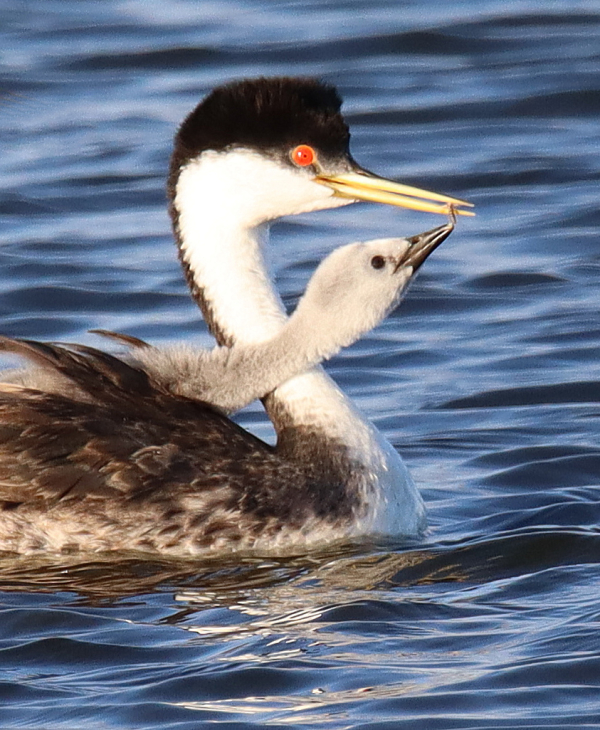
A second opportunity to photograph families of Western Grebes provided another series of photos that included young hatchlings.
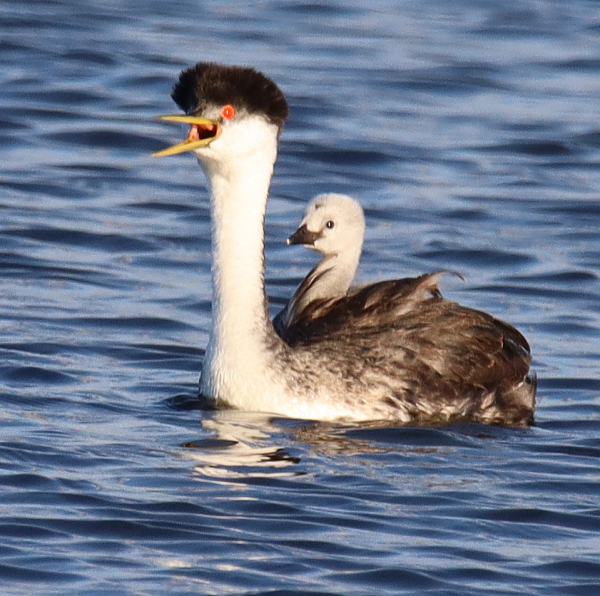
The grebes were involved in a variety of activities to observe and photograph during the Sunday evening photo session.

The larger downy grebes didn’t ride the adult’s back, but they seemed to have a bottomless hunger for fish the adults were catching and feeding them.
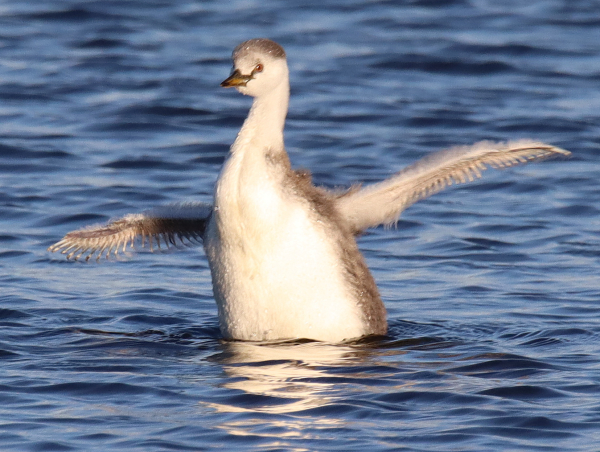
Doing its best penguin impression, a large downy Western Grebe stretches its growing wings.
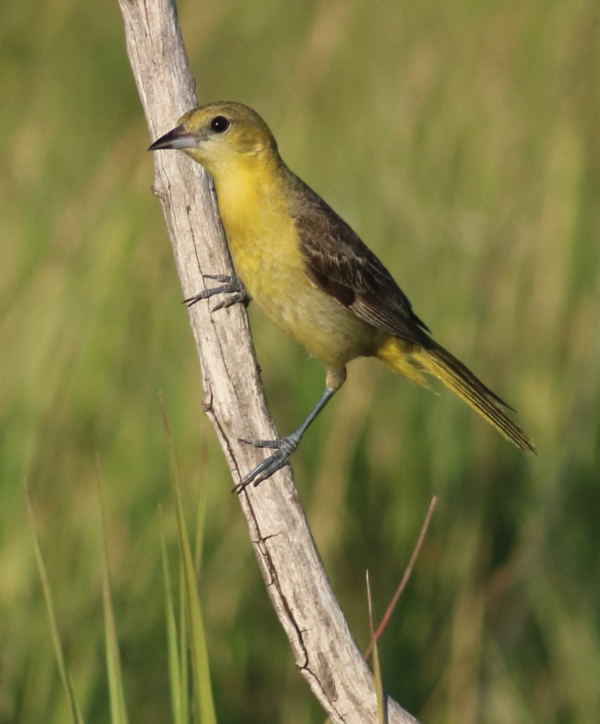
This fledgling Orchard Oriole was one of many observed foraging in a prairie area.
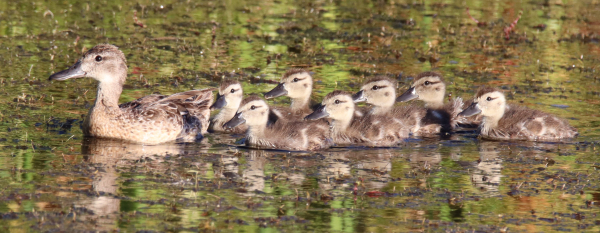
Monday evening, a female Blue-winged Teal led her brood of week-old Blue-winged Teal ducklings to a shallow feeding area.
|
By Sunday I was looking for more action than I was getting on my usual birding routes, so as the clouds parted after 4pm I dallied with the idea of visiting the wading bird nesting colony, which should also provide photo ops for ducks and grebes. By the time I was 10 miles south of my office, it was a go, and an hour later I was photographing a maturing brood of Redheads, a couple broods of Ruddy Ducks were next, but ultimately, families of Western Grebes came through again. And this time there was quite an age range among hatchlings between 1 week and 5 weeks of age – all in broods of 2 or 1.
The photo opportunities with the grebes became more and more exciting as the sun dropped lower and lower in the sky. I wrote about this location about a month ago, and actually, it turned out that I visited the wading bird nesting colony exactly a month earlier on July 7th. Again, the wading bird photography was a bust; but the grebes surprised me by the varied ages of hatchlings. This time I photographed 4 different family groups of Western Grebes, and any outing when I can spend 40 minutes photographing interesting wildlife non-stop during the peak lighting period of the evening, it’s hard to beat. Plus, the action included an Eared Grebe feeding a week-old hatchling in addition to the Western Grebes. With a slight wind and eventual blue sky, the placid water provided a nice setting for photos.
Although I did take portrait photos of some adult grebes, partly due to the beauty of the light and water, it was the downy hatchlings that made the photos come alive as the larger hatchlings waited for a diving adult to surface with the next fish; then the begging and food transfer actions began. Better yet were the small downies that were riding on the back of some adults. One pair in particular provided an extended opportunity to photograph them as each adult carried a hatchling. They presented the potential of photographs of the pair of adults together, each with a downy little grebe poking its head out of their back feathers.
The potential was there, but when you’re hoping each of the 4 birds will position themselves in sync while taking a given photo, it can turn out to be wishful thinking. And while I didn’t get the ultimate photo of the pair with hatchlings riding on their backs, I did get some nice images of a single adult with a downy peeking through its feathers. During the photo process, it was especially rewarding to observe the grebes and their interactions, and it makes me wish to return – but soon before the youngest downies grow beyond the cutest stage.
Other birds in the area included a wealth of American Coots and Pied-billed Grebes, along with a variety of ducks, plus the nesting Great Egrets, Great Blue Herons, and Double-crested Cormorants. There were also a few White Pelicans, Black Terns and Common Terns, Spotted Sandpipers, and a sleeping Black-crowned Night Heron; but surprisingly, no White-faced Ibis.
Prairie Aves
Area prairies have been in flux lately with the changes from the nesting season to the post-nesting and dispersal period that follows. Some species are gathering in ever-larger flocks, including Tree Swallows, Yellow-headed Blackbirds, Red-winged Blackbirds, and even some species of native sparrows and Bobolinks. Last Wednesday I enjoyed watching a large group of post-nesting Orchard Orioles numbering a minimum of 10 fledglings and females (which are difficult to tell apart in the field), but there was only a single adult male among them.
All the orioles were foraging for insects in a native prairie area between a wetland and a grove of trees, with some fledglings occasionally begging for food while also foraging on their own. A standout sighting was a fledgling Brown Cowbird that was begging from and being fed by a female Orchard Oriole, which was testament to a female cowbird laying an egg in the oriole’s nest and successfully having the oriole raise the young cowbird, as cowbirds do. Duck broods are continuing to hatch across the Coteau, and Wednesday evening I saw a new Gadwall brood of 4 ducklings, and a week-old brood of 4 Redheads. There were also a couple widely scattered Spotted Sandpipers on the edge of area wetlands, but no migrating shorebirds recently. I also photographed the first fledgling Red-tailed Hawk I’ve seen in the area, hopefully with more to follow soon, along with Swainson’s Hawk fledglings.
I only had a short window of time to enjoy some very local birding Monday, venturing just 2 miles south of home and 2 miles north, but the effort paid off enormously. To the south, I sighted a hen with her brood of 5 fully grown Ring-necked Pheasants, the second pheasant brood I found during the week. At Melody’s Marsh, just a half-mile south, I could see 3 duck broods, a newly hatched brood of 7 Mallard ducklings and 2 older Blue-winged Teal broods. To the north, a shallow bay on the edge of an expansive marsh held 2 more Blue-winged Teal broods numbering 7 each; 1 brood of ducklings was newly hatched and 1 was about a week old. The older brood provided some very nice photos at close range, which made the short outing especially fruitful.
Out My Windows
At my feeding station and the surrounding trees, a yearling Baltimore Oriole stops in for grape jelly and tastes of the cut oranges daily, along with an occasional drink of water – I usually see it a few times each day. Saturday and Monday I noticed a second darker yearling was feeding on jelly too, and I’m hoping more dispersing orioles find my oriole feeder during coming days and weeks.
House Finches are now the most common feeding station visitors, and it’s interesting to note that robins have stopped feeding on grape jelly and using my bird bath the past 10 days. It’s also worth mentioning that I haven’t seen any young robins during that period, and fewer adult American Robins are present in the neighborhood, suggesting some dispersal among these thrushes. And the Gray Catbirds seem to have left as of Saturday evening, when I saw and heard the last one at my jelly feeder.
Throughout the past week I enjoyed seeing a Yellow Warbler foraging for bugs in the trees outside my bay windows, and it makes me wonder if these are sightings of a single bird or a group of birds. Monday I was inclined to think that it was a lone male with faded plumage that remained after an initial group of Yellow Warblers, but Tuesday I was inundated by Yellow Warblers with a minimum of 5 foraging through my sumacs and the elm tree adjacent to my feeding station; 1 also stopped for a quick splash in my bird bath.
Now I hope more Yellow Warblers will remain in the area, joined with a greater variety of dispersing and migrating warblers, orioles, and other songbirds in the coming days and weeks. This period can be exciting when suddenly a new species or a species we haven’t seen since spring migration, or during a previous year suddenly appears in our yard, neighborhood, or surrounding region. Enjoy the changes of this late summer period, and make some extra time to explore the seasonal variety among the avifauna in your area.
Article and photos by Paul Konrad
Share your bird sightings and photographs at editorstbw2@gmail.com